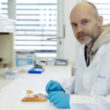Helt konge
Product quality of undersized king crabs after long-term feeding

In this project, we will investigate the relationships between conditions for live storage (environment) and feeding (dry feed) of small king crabs through 1-3 shell changes and the quality of the product after processing.
Start
01. Feb 2022
End
30. Jun 2025
Funded by
Nofima
Background
We believe that knowledge about live storage and feeding of small king crabs and the impact it has on muscle quality is in high demand nationally and internationally. Establishing such knowledge is also in line with Nofima’s goal of being a leading business-oriented research institute that conducts research and development for the aquaculture, fisheries and food industries.
If we reach our project goal, the new knowledge will create a basis for projects in catch-based aquaculture on king crabs, which in the next step can provide new establishments.
It should be emphasized here that our activity has built up one of the strongest interdisciplinary research environments in the world with respect to king crabs and snow crabs. Among other things, this has provided synergies in the form of large projects nationally (e.g. SnowMap and Fishery at 78°) and internationally (e.g. CruWel).
Other projects
The new marine industry will include several steps in the value chain: the catch phase, with more targeted fishing for small crabs in fish-free areas, land-based live storage with feeding, and industrial processing.
With knowledge of how live storage of small king crabs is to be carried out, there will be a potential for increasing the export volume as the opportunities for growth in the quota-regulated area are limited.
Although Nofima is currently the world’s foremost interdisciplinary research environment for snow crabs and king crabs, we foresee a shift in the demand for knowledge towards catch-based aquaculture. We assume that the main reason for this is the high taxation of king crabs in the quota-regulated area.
Crabs are caught with injuries, and often the animals lack legs/claws due to previous careless handling. At times, the meat filling can also be low, which can be linked to either a low food supply or that the crab’s ability to eat the food is limited due to catch damage in connection with re-release. Such a fishery is not sustainable.
However, the fishery can be made sustainable with a controlled live storage and feeding of small crabs. A targeted fishery for small king crabs in fish-free areas will contribute to a reduction in the distribution of the crab along the coast.
By implementing the project “Helg konge”, Nofima will maintain its position as the world’s foremost expertise environment for crabs.
Objectives
The main objective of the project is to investigate the relationships between conditions for live storage (environment) and feeding (dry feed) of small king crabs through 1-3 shell changes and the quality of the product after processing.
Subsidiary objectives
Sub-goals in the project are:
- Define optimal environmental conditions for live storage; density, size distribution, design of vessels/gutters, water quality, current, light and temperature. Carry out live storage (injury frequency, meat content (NIR), shell change frequency, welfare, etc.
- Develop a sustainable feed with optimal composition, good technical properties, high water stability and low feed loss. Define feeding regimens.
- Characterize whole live crab using photos. Standardize conditions that meet the requirements for further data analysis
- Map gene expression for growth and shell change regulation
- Industrial processing and yield calculations, characterize hepatopancreas
- Characterize muscle
- Experimental design and results processing: define experimental setups and clarify connections between live storage conditions and muscle quality, big data, create procedures and systems for registrations and data processing
This is what we will do
In December 2019, small king crabs (approx. 0.5 kg) were caught in Eidkjosen, and transported to Kårvika for live storage and feeding on a small scale. As of February 2022, the crabs had undergone 3 shell changes, and achieved commercial sizes (>1.6 kg). The results are encouraging, as the crabs have eaten the feed (mainly krill and bycatch from shrimp trawls), while at the same time there was a very low mortality.
These positive results give us clear indications and expectations that this is possible.
We will start processing these crabs and then characterize the muscle quality (ref. sub-goals 3, 4, 5 and 6) and compare the results with the conditions for live storage. This will give us good experience with the methods to be used for characterization.
Based on the findings, experiments for live storage will be designed (ref. sub-goal 7), and the type of feed and feeding regime will be defined (ref. sub-goal 2) before we start with live storage (ref. sub-goal 1).
A total of 2.5 years has been set aside for live storage, and if we start with crabs just below commercial weight, one shell change will probably be sufficient before the crab reaches a commercial size. If the starting weight is lower, it will take longer, and there will be more shell changes.
In our experiments, we achieved a weight gain of a maximum of 40% after one year with 2-3 shell changes. Nevertheless, we do not currently have sufficient knowledge of which conditions for live storage have been decisive for such a result.
Publications
Strategic priority areas
Nofima invests its own resources in order to increase competence in useful, relevant and innovative areas and strengthen our position among the leading applied research institutes.
Active projects
Some previous projects
Research facilities





